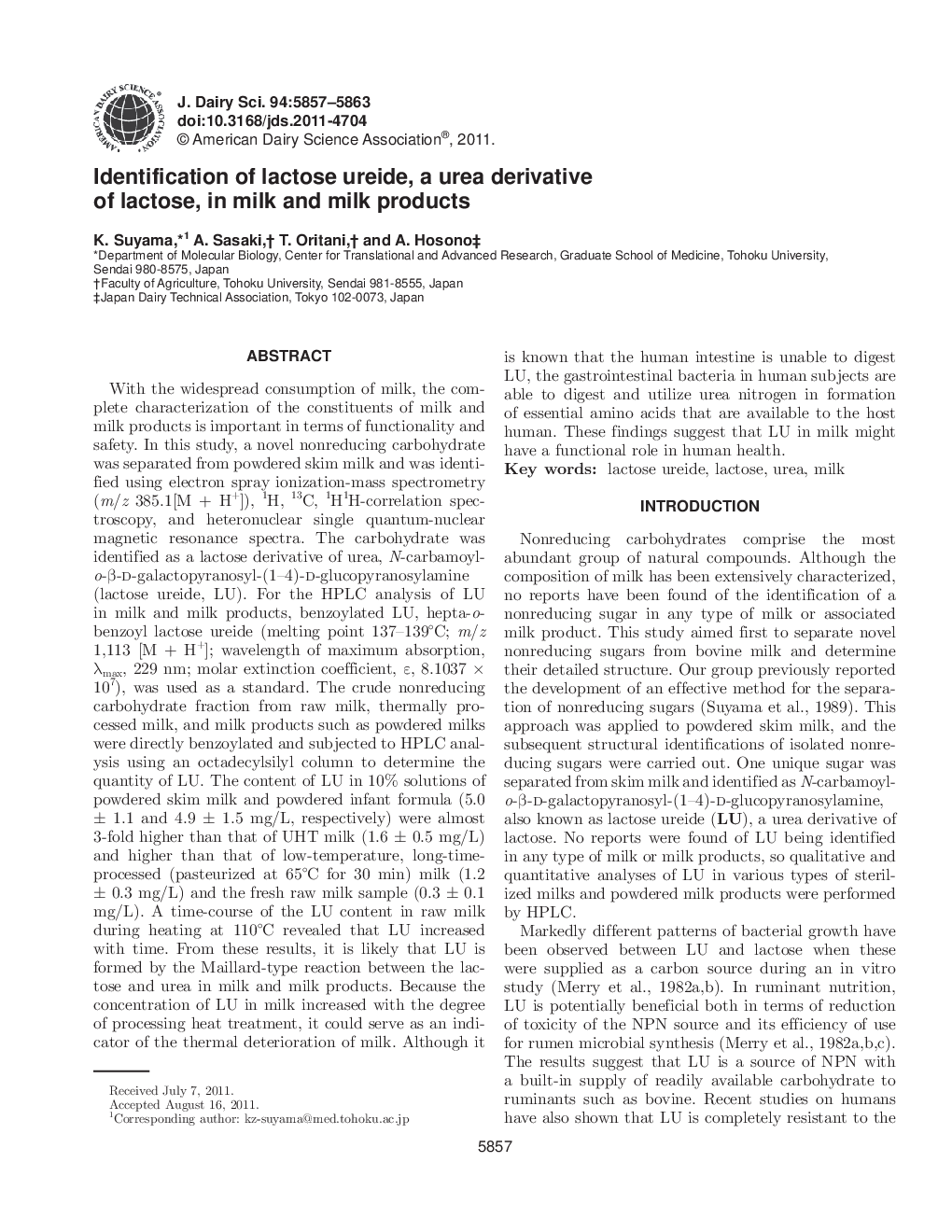| کد مقاله | کد نشریه | سال انتشار | مقاله انگلیسی | نسخه تمام متن |
|---|---|---|---|---|
| 10981643 | 1108078 | 2011 | 7 صفحه PDF | دانلود رایگان |
عنوان انگلیسی مقاله ISI
Identification of lactose ureide, a urea derivative of lactose, in milk and milk products
دانلود مقاله + سفارش ترجمه
دانلود مقاله ISI انگلیسی
رایگان برای ایرانیان
کلمات کلیدی
موضوعات مرتبط
علوم زیستی و بیوفناوری
علوم کشاورزی و بیولوژیک
علوم دامی و جانورشناسی
پیش نمایش صفحه اول مقاله

چکیده انگلیسی
With the widespread consumption of milk, the complete characterization of the constituents of milk and milk products is important in terms of functionality and safety. In this study, a novel nonreducing carbohydrate was separated from powdered skim milk and was identified using electron spray ionization-mass spectrometry (m/z 385.1[M + H+]), 1H, 13C, 1H1H-correlation spectroscopy, and heteronuclear single quantum-nuclear magnetic resonance spectra. The carbohydrate was identified as a lactose derivative of urea, N-carbamoyl-o-β-d-galactopyranosyl-(1-4)-d-glucopyranosylamine (lactose ureide, LU). For the HPLC analysis of LU in milk and milk products, benzoylated LU, hepta-o-benzoyl lactose ureide (melting point 137-139 °C; m/z 1,113 [M + H+]; wavelength of maximum absorption, λmax, 229 nm; molar extinction coefficient, ε, 8.1037 à 107), was used as a standard. The crude nonreducing carbohydrate fraction from raw milk, thermally processed milk, and milk products such as powdered milks were directly benzoylated and subjected to HPLC analysis using an octadecylsilyl column to determine the quantity of LU. The content of LU in 10% solutions of powdered skim milk and powdered infant formula (5.0 ± 1.1 and 4.9 ± 1.5 mg/L, respectively) were almost 3-fold higher than that of UHT milk (1.6 ± 0.5 mg/L) and higher than that of low-temperature, long-time-processed (pasteurized at 65 °C for 30 min) milk (1.2 ± 0.3 mg/L) and the fresh raw milk sample (0.3 ± 0.1 mg/L). A time-course of the LU content in raw milk during heating at 110 °C revealed that LU increased with time. From these results, it is likely that LU is formed by the Maillard-type reaction between the lactose and urea in milk and milk products. Because the concentration of LU in milk increased with the degree of processing heat treatment, it could serve as an indicator of the thermal deterioration of milk. Although it is known that the human intestine is unable to digest LU, the gastrointestinal bacteria in human subjects are able to digest and utilize urea nitrogen in formation of essential amino acids that are available to the host human. These findings suggest that LU in milk might have a functional role in human health.
ناشر
Database: Elsevier - ScienceDirect (ساینس دایرکت)
Journal: Journal of Dairy Science - Volume 94, Issue 12, December 2011, Pages 5857-5863
Journal: Journal of Dairy Science - Volume 94, Issue 12, December 2011, Pages 5857-5863
نویسندگان
K. Suyama, A. Sasaki, T. Oritani, A. Hosono,